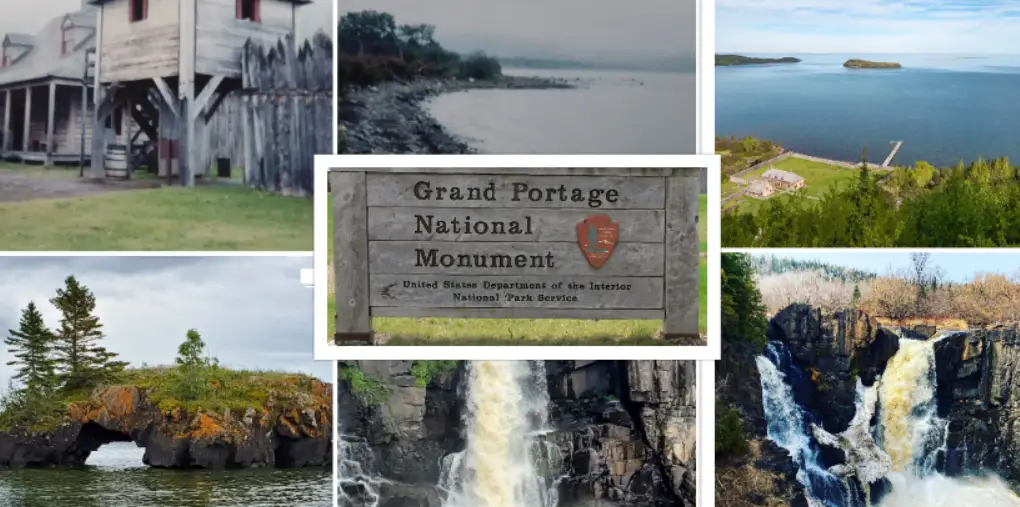Grand Portage National Monument : Interesting Facts, History & Travel Guide

- By
- Aparna Patel
- |
- 1 Apr, 2023
- |

Grand Portage National Monument is a historical site located in northeastern Minnesota, USA that preserves a portion of the Grand Portage, a fur trade route used by Ojibwe Indians and French-Canadian voyageurs in the 18th century.
In this blog, we will delve into the interesting history of Grand Portage, explore the different things visitors can do at the park, and provide a helpful travel guide for those planning a trip to this unique destination.
Table of Contents
Interesting facts about Grand Portage National Monument
- Grand Portage National Monument is located in northeastern Minnesota, near the Canadian border. The monument preserves a historic fur trading post and the route used by fur traders to transport their goods between Lake Superior and inland trading posts.
- The name “Grand Portage” comes from the French word “portage,” which means to carry a boat or goods overland. The grand portage was a 9-mile overland route used by fur traders to bypass the dangerous rapids of the Pigeon River.
- The monument’s historic fur trading post was built by the North West Company in the late 18th century. The post was a major center of the fur trade in the region and served as a hub for the trading of furs from Native American tribes in the area.
- The grand portage was an important route for the fur trade and was used by thousands of traders over the years. It was also used by the Ojibwe and other Native American tribes for centuries before the arrival of Europeans.
- Grand Portage National Monument was established in 1958 and is managed by the National Park Service. The monument includes a reconstructed trading post, a museum, and several historic buildings.
- Visitors to the monument can hike the grand portage trail, which follows the historic route used by fur traders. The trail includes steep hills, rocky terrain, and scenic views of the surrounding forests and lakes.
- The monument also hosts an annual Rendezvous festival, which celebrates the history and culture of the fur trade era. The festival includes reenactments, demonstrations of traditional skills, and live music and entertainment.
- Grand Portage National Monument is also home to the tallest waterfall in Minnesota, the High Falls of the Pigeon River, which drops 120 feet over a series of cascades. Visitors can view the falls from a scenic overlook or hike to the bottom for a closer look.
Information & History of Grand Portage National Monument
The fur trade was a major economic activity in the region during the 18th and early 19th centuries. The North West Company established a trading post at Grand Portage in the late 1700s, which became a major center of the fur trade in the region. The post served as a hub for the trading of furs from Native American tribes in the area, including the Ojibwe, Cree, and Assiniboine.
The grand portage was a 9-mile overland route used by fur traders to bypass the dangerous rapids of the Pigeon River. The route was essential for transporting furs and other goods between Lake Superior and the interior of the continent. The portage involved carrying canoes and goods overland, which was a challenging and labor-intensive task.
The fur trade declined in the mid-19th century, and the trading post at Grand Portage was eventually abandoned. In the 1920s, the site was acquired by the Minnesota Historical Society, which worked to preserve and restore the historic buildings.
In 1958, Grand Portage National Monument was established to preserve the historic site and the grand portage trail. The monument includes a reconstructed trading post, a museum, and several historic buildings. Visitors can hike the grand portage trail, which follows the historic route used by fur traders, and learn about the history and culture of the fur trade era.
Today, Grand Portage National Monument is managed by the National Park Service and is a popular destination for visitors interested in history, culture, and outdoor recreation. The monument is also home to the tallest waterfall in Minnesota, the High Falls of the Pigeon River, which is a popular attraction for visitors.
Read More:
- Grand Canyon–Parashant National Monument : Interesting Facts, History & Travel Guide
- Governors Island National Monument : Interesting Facts, History & Travel Guide
- Gold Butte National Monument : Interesting Facts, History & Travel Guide
- Gila Cliff Dwellings National Monument : Interesting Facts, History & Travel Guide
- Giant Sequoia National Monument : Interesting Facts, History & Travel Guide
Travel Guide for Grand Portage National Monument
Getting There: Grand Portage National Monument is located in northeastern Minnesota, about 150 miles northeast of Duluth. The nearest airport is Duluth International Airport, which is served by several major airlines. From there, you can rent a car and drive to the monument. The monument is located off of Highway 61, which runs along the North Shore of Lake Superior.
Things to Do:
- Visit the Trading Post: The reconstructed trading post at Grand Portage National Monument is a highlight of any visit. You can tour the historic buildings, learn about the fur trade era, and see demonstrations of traditional skills like blacksmithing and weaving.
- Hike the Grand Portage Trail: The grand portage trail is a 9-mile overland route used by fur traders to transport their goods between Lake Superior and inland trading posts. You can hike a portion of the trail and see scenic views of the surrounding forests and lakes.
- Visit the High Falls of the Pigeon River: The tallest waterfall in Minnesota is located within the boundaries of Grand Portage National Monument. You can view the falls from a scenic overlook or hike to the bottom for a closer look.
- Attend the Rendezvous Festival: Every August, Grand Portage National Monument hosts a Rendezvous festival, which celebrates the history and culture of the fur trade era. The festival includes reenactments, demonstrations of traditional skills, and live music and entertainment.
- Explore the Local Area: The North Shore of Lake Superior offers many opportunities for outdoor recreation, including hiking, fishing, and kayaking. You can also explore nearby attractions like the Boundary Waters Canoe Area Wilderness and Isle Royale National Park.
Where to Stay: There are several lodging options in the area, including hotels, cabins, and campgrounds. The Grand Portage Lodge and Casino is located near the monument and offers hotel rooms, a restaurant, and a casino. There are also several campgrounds in the area, including the Grand Portage State Park Campground and the Grand Portage National Monument Campground.
When to Go: Grand Portage National Monument is open year-round, but the best time to visit is during the summer months when the weather is warm and the festival season is in full swing. The Rendezvous festival is held in August and is a popular time to visit the monument. Fall is also a beautiful time to visit when the leaves change colors.
With its rich history and beautiful natural surroundings, Grand Portage National Monument is a great destination for anyone interested in learning about the fur trade era and experiencing the beauty of northern Minnesota.
More Articles:
- George Washington Carver National Monument : Interesting Facts, History & Travel Guide
- Freedom Riders National Monument : Interesting Facts, History & Travel Guide
- Fossil Butte National Monument : Interesting Facts, History & Travel Guide
- Fort Union National Monument : Interesting Facts, History & Travel Guide
- Fort Stanwix National Monument : Interesting Facts, History & Travel Guide
- Fort Matanzas National Monument : Interesting Facts, History & Travel Guide
- Florissant Fossil Beds National Monument : Interesting Facts, History & Travel Guide
- Fort Frederica National Monument : Interesting Facts, History & Travel Guide
FAQ about Grand Portage National Monument
Q: When was Grand Portage National Monument established?
A: Grand Portage National Monument was established on January 29, 1958.
Q: What is the history of Grand Portage?
A: The Grand Portage was a vital link between the Great Lakes and the interior of North America. It was used by Ojibwe Indians for centuries and later by French-Canadian voyageurs who traded furs with the Ojibwe.
Q: What can visitors do at Grand Portage National Monument?
A: Visitors can explore the historic site, which includes a reconstructed trading post and a Native American encampment. They can also hike the Grand Portage Trail, which follows the route of the fur traders.
Q: Is there an admission fee for Grand Portage National Monument?
A: There is no admission fee for Grand Portage National Monument.
Q: What are the hours of operation for Grand Portage National Monument?
A: Grand Portage National Monument is open year-round, but hours vary by season. The visitor center is typically open from 8:30am to 5pm in the summer and from 9am to 4:30pm in the winter.
Q: Are there any special events or programs at Grand Portage National Monument?
A: Yes, the park offers a variety of events and programs throughout the year, including cultural demonstrations, guided hikes, and historical reenactments.
Q: Can visitors camp at Grand Portage National Monument?
A: No, there is no camping allowed at Grand Portage National Monument. However, there are several campgrounds nearby.
Q: Is Grand Portage National Monument accessible for people with disabilities?
A: Yes, the park is partially accessible for people with disabilities. The visitor center and some trails are wheelchair accessible, but the historic buildings may have limited accessibility.
Q: Is there a gift shop at Grand Portage National Monument?
A: Yes, there is a gift shop at the visitor center that sells books, maps, souvenirs, and other items related to the park and the fur trade era.
Search Posts
Latest posts
-
5 Mar, 2024
Why prohibit engine braking?
-
5 Mar, 2024
Passing through airport security with autism
-
4 Mar, 2024
Can I accidentally miss the in-flight food?
Popular posts
-
5 Mar, 2024
Why prohibit engine braking?
